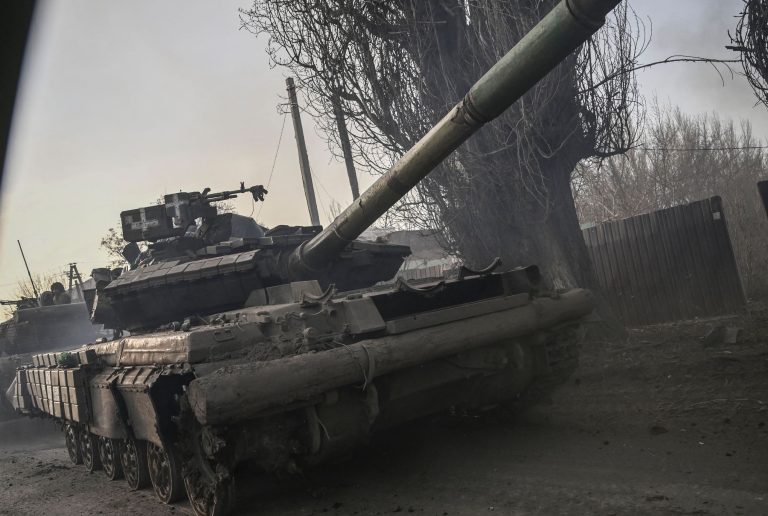Troops of the Wagner private military company (PMC) and Russian army on April 4 took a government administration building and reached a hospital in their efforts to take the AZOM steel plant industrial sector in Bakhmut, eastern Ukraine. The advances were followed up by a strong push in the center of the city that overwhelmed the AZOM plant and threatens the defenders’ positions.
Fighting for the key city has been fierce since February, when Russian forces succeeded in taking villages to the north and south of Bakhmut, operationally encircling it and tens of thousands of Ukrainian troops caught in the salient.
The battle has seen heavy shelling from both sides, with Russian progress being very slow due to the cautious nature of their advance and stiff resistance from the Ukrainian defenders both in Bakhmut and to the west, in settlements such as Ivanivske and Chaisv Yar that control the last highway between Bakhmut and the rest of the country.
In late March, the Ukrainian Armed Forces announced an upcoming counteroffensive involving multiple newly formed “assault brigades” that will consist of Western-trained soldiers equipped with advanced weapons such as the German Leopard 2 and British Challenger tanks.
Observers believe the planned counteroffensive is likely to focus on throwing back the Russian military presence surrounding Bakhmut and defeating the Wagner assault on the city, relieving the defenders.
Success
You are now signed up for our newsletter
Success
Check your email to complete sign up
The Ukrainian authorities have not revealed the geographic focus on the upcoming offensive, but Kiev has already invested tens of thousands of men in Bakhmut, and the city is an important logistical hub, strategic defensive point in the Donbass front, and the subject of promises by the Ukrainian government to hold the line.
YouTuber WeebUnion (WU), a satirically named channel that covers day-to-day developments in the Russo-Ukrainian war, reported on Wagner PMC’s capture of the government office in an April 4 video, basing his claims on triangulation of several sources.
He noted that control of about nine other city blocks to the south-southeast of the office was contested and could not be determined, but the next day determined that these blocks had fallen to the Russian forces.
WU called the latest Russian advance “rapid” given that many blocks had fallen in just two days as opposed to the weeks that it took the Wagner PMC to advance through other parts of the city.
On April 4, WU directed attention to a prediction he made in a March 25 report, to the effect that as the Wagner mercenaries take the AZOM steel plant, it would open up opportunities for them to make a breakthrough towards the south and jeopardize Ukrainian defenders in the easternmost parts under their control.
The latest advance put the Russian forces within a couple blocks of the Bakhmut train station, which could be a key landmark for the invaders’ strategy.
“The Russian forces are looking to cut the eastern parts of these rail lines into two smaller pockets, after which they’ll take them one at a time,” WU predicted, referring to the north-south railway that as of press time still lies in Ukrainian-held territory.
Until recently, Wagner PMC was the main force behind the urban assault in Bakhmut, while regular Russian troops, including the VDV airborne troops, were largely responsible for defending the flanks to the north and south.
Of late, Gen. Sergey Surovikin, the Russian commander nicknamed “General Armageddon” for his liberal use of airstrikes, has been leading regular army forces in the city alongside Wagner PMC, which is headed by oligarch Yevgeniy Prigozhin.
Ukrainian President Volodymyr Zelensky has hedged his bets on stalling the Russians at Bakhmut, warning that if the city fell, it could dampen international support for Ukraine and also increase domestic pressure to sue for peace with the Kremlin.
“Our society will feel tired,” he said in a March 28 interview with AP on a train while surverying the front lines. “Our society will push me to have compromise with them.”
Russian military presence in Bakhmut was previously limited to the eastern half of the city, with the Wagner group completing its capture of the settlement up to the Bakhmutova river in previous weeks.
WU and other commentators note that heavy rains and an unexpected fit of spring snow would likely hamper the Ukrainian counteroffensive, due to the precipitation turning roads and fields into mud unsuitable for crossing by heavy vehicles.
The development of multiple Russian thrusts has created various pockets on resistance, wherein the Ukrainians will either be cut off, or withdraw to the western parts of Bakhmut. Beyond the rail line, the Ukrainian army has a strong fortified zone in the westernmost residential district of the city.















